The Polyglycerol Sebacate Market is estimated to be valued at USD 80.1 million in 2025 and is projected to reach USD 219.4 million by 2035, registering a compound annual growth rate (CAGR) of 10.6% over the forecast period. This translates to an average annual addition of nearly USD 12.7 million. The absolute expansion in yearly terms starts with USD 8.5 million between 2025 and 2026, increases to USD 9.4 million the following year, and surpasses USD 20 million by 2035.
Across the timeline, the contribution from the second half of the forecast window (2030 to 2035) outweighs the earlier half. Between 2025 and 2030, the increase sums to USD 52.5 million, while the period from 2030 to 2035 yields a larger gain of USD 86.8 million.
Specifically, annual increments grow from USD 13.7 million in 2030 to USD 21.0 million in 2035, underscoring a sharper uptrend in latter years. The widening yearly additions indicate that early-stage growth lays the foundation for compounded gains in the final half of the timeline. Each subsequent year adds more than the last, with momentum visible in the expanding increments. The data pattern supports a structurally advancing market scale, wherein later years deliver significantly higher absolute dollar gains than initial years.
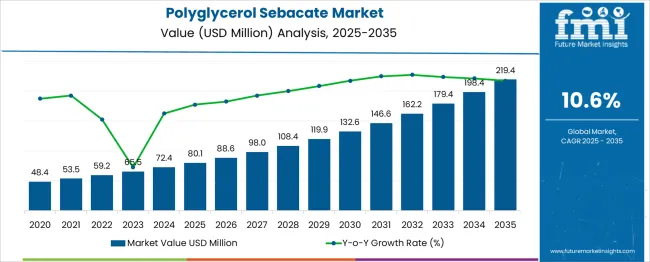
| Metric | Value |
|---|---|
| Polyglycerol Sebacate Market Estimated Value in (2025 E) | USD 80.1 million |
| Polyglycerol Sebacate Market Forecast Value in (2035 F) | USD 219.4 million |
| Forecast CAGR (2025 to 2035) | 10.6% |
The polyglycerol sebacate market is witnessing increasing momentum, driven by its high biocompatibility, tunable mechanical properties, and biodegradability. Rising demand in biomedical engineering and pharmaceutical formulations is creating significant interest in this elastomer as a sustainable alternative to conventional polymers.
Regulatory support for bioresorbable materials in medical and pharmaceutical use has accelerated R&D investment and product standardization. The ability of polyglycerol sebacate to support controlled drug release, tissue regeneration, and minimal inflammatory response has positioned it as a preferred material for long-term therapeutic applications.
Moreover, as pharmaceutical companies prioritize green chemistry and high-purity raw materials, the adoption of polyglycerol sebacate is expected to expand across preclinical studies and advanced formulation platforms. The market outlook remains positive with continuous innovation in synthesis methods, scale-up feasibility, and crosslinking techniques tailored to application-specific requirements.
The polyglycerol sebacate market is segmented by form, application, and geographic regions. The polyglycerol sebacate market is divided into Soft gel, Paste, Extruded products, and others. In terms of application, the polyglycerol sebacate market is classified into Drug delivery, Tissue engineering, Adhesives, Coatings, and others.
Regionally, the polyglycerol sebacate industry is classified into North America, Latin America, Western Europe, Eastern Europe, Balkan & Baltic Countries, Russia & Belarus, Central Asia, East Asia, South Asia & Pacific, and the Middle East & Africa.
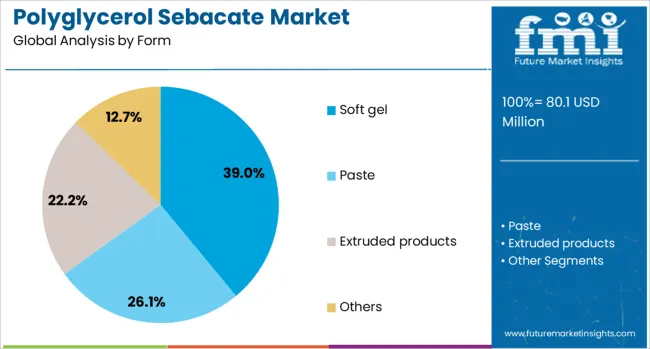
Soft gel formulations are projected to account for 39.0% of the total revenue in the polyglycerol sebacate market by 2025, making them the leading form segment. This leadership is attributed to their enhanced bioavailability, flexibility in encapsulating both hydrophilic and lipophilic drugs, and improved patient compliance.
The mechanical softness and flexibility of polyglycerol sebacate in soft gel form enable efficient administration and targeted release in pharmaceutical and medical implant applications. Additionally, its high degradation control and elastomeric consistency support complex biomedical formulations.
The manufacturing adaptability and ability to maintain structural integrity under physiological conditions have further contributed to its rising preference across drug development pipelines. As biopolymer demand grows in minimally invasive delivery systems, soft gel remains a critical application format.
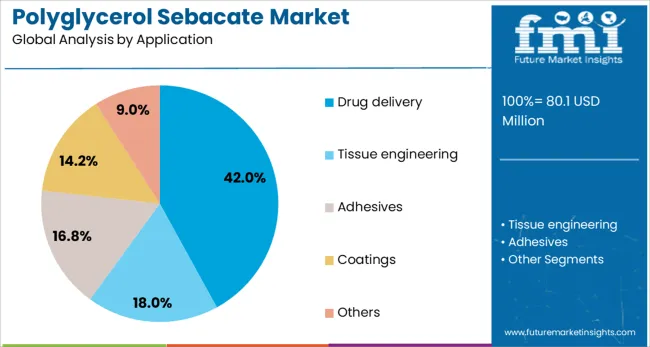
Drug delivery is expected to represent 42.0% of the polyglycerol sebacate market revenue in 2025, establishing it as the most dominant application segment. This prominence is due to the material’s biocompatibility and degradation profile, which allow for customizable drug loading, release kinetics, and therapeutic targeting.
Its use in nanoparticle and hydrogel platforms has enabled sustained and localized drug delivery with minimal toxicity. Polyglycerol sebacate's mechanical and surface characteristics have also proven beneficial in adhering to soft tissue interfaces, which enhances its role in both systemic and site-specific applications.
As regulatory agencies increasingly endorse safer, biodegradable carriers for complex therapies, the deployment of this polymer in drug delivery systems is anticipated to grow steadily across both academic research and commercial development pipelines.
The polyglycerol sebacate market has emerged as a critical segment within specialty polymers, largely due to its desirable biocompatibility and elastomeric properties. This polyester has found increasing usage in biomedical, pharmaceutical, cosmetic, and tissue engineering applications where flexibility, non-toxicity, and biodegradability are required. Derived from glycerol and sebacic acid, it has offered an alternative to synthetic elastomers with lower environmental and physiological compatibility. Academic and industrial research activities have driven innovations in synthesis, crosslinking techniques, and formulation stability. As regulatory standards for biopolymers grow stringent across sectors, polyglycerol sebacate has gained relevance for use in advanced drug delivery, scaffolding materials, and cosmetic emulsions.
In biomedical engineering, polyglycerol sebacate has been favored for applications in soft tissue repair, vascular grafts, nerve regeneration, and wound healing. Its mechanical properties, closely mimicking natural tissues, have facilitated its use as a scaffold material for cell growth and implantation. Crosslinking strategies such as UV irradiation or thermal curing have been developed to tailor degradation rates and elasticity. Research in cardiovascular and neural tissue scaffolds has validated its hemocompatibility and in vivo safety. Integration with other biomaterials like collagen or chitosan has further expanded its utility in composite biomaterials. As demand for personalized medical devices and regenerative therapies continues to rise, the need for bioresorbable elastomers such as polyglycerol sebacate has been reinforced.
In the cosmetics sector, polyglycerol sebacate has been incorporated into emulsifiers, moisturizers, and skin care formulations. Its non-comedogenic and biodegradable nature has made it appealing for use in skin-contact products. The ability to enhance water-in-oil emulsion stability and deliver active compounds in a controlled manner has enabled its adoption by formulators seeking alternatives to synthetic silicones and PEGs. Its mild skin interaction profile has been validated through dermatological testing. Brands have begun utilizing it in hydrating creams, sunscreen bases, and anti-aging formulations. As consumer preference shifts toward ingredient transparency and safety, this polymer has served as a viable candidate for replacing legacy components while preserving performance standards.
Significant research has been conducted to improve the synthesis efficiency, molecular weight control, and scale-up feasibility of polyglycerol sebacate. Variations in monomer ratios, reaction temperatures, and catalysts have been studied to tune polymer architecture. Universities and biotech startups have collaborated to develop low-temperature processing methods and solvent-free synthesis routes that align with green chemistry principles. Patents have been filed on modified derivatives such as acrylated or maleated polyglycerol sebacate to enhance functionality and adhesion. These advancements have addressed earlier limitations such as long curing times and limited shelf stability. Improved reproducibility and scalability have strengthened its positioning for commercial production in both healthcare and industrial applications.
Despite its functional appeal, the polyglycerol sebacate market has been constrained by limited industrial-scale production and relatively high manufacturing costs. Purification of monomers and stringent synthesis conditions have elevated production overhead. Limited availability of high-purity sebacic acid and refined glycerol has also impacted raw material sourcing. Batch variability has posed challenges in achieving consistent mechanical and degradation profiles for medical-grade products. Additionally, regulatory approvals for biomedical applications have required significant investment in clinical validation and biocompatibility studies. Without broader production infrastructure, quality standardization, and downstream partnerships, market expansion may remain concentrated within niche, high-value applications.
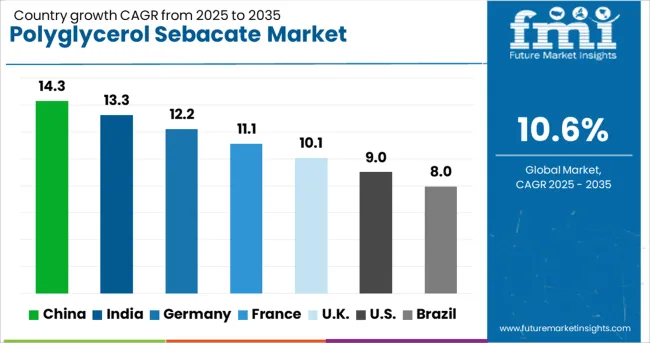
| Country | CAGR |
|---|---|
| China | 14.3% |
| India | 13.3% |
| Germany | 12.2% |
| France | 11.1% |
| UK | 10.1% |
| USA | 9.0% |
| Brazil | 8.0% |
The polyglycerol sebacate market is projected to expand at a CAGR of 10.6% between 2025 and 2035, driven by its increasing adoption in biomedical implants, tissue engineering scaffolds, and cosmetic formulations. China, with a growth rate of 14.3%, leads due to well-established biodegradable polymer infrastructure and scaling R&D programs in regenerative medicine. India follows at 13.3%, supported by government-backed research in bio-based materials and rising local manufacturing of specialty polymers. Germany, expected to grow at 12.2%, benefits from advanced synthetic chemistry clusters and demand from medical device suppliers. The UK, growing at 10.1%, remains active in commercializing polyglycerol sebacate through academic-industrial collaborations. The USA, with 9.0% CAGR, sees increased demand from tissue engineering labs and clean-label cosmetic brands. This report includes insights on 40+ countries; the top markets are shown here for reference.
China is expected to witness a CAGR of 14.3% in the polyglycerol sebacate market between 2025 and 2035 due to the country’s aggressive biomedical research output and rising domestic demand for bioresorbable polymers. Chinese pharmaceutical manufacturers are integrating PGS into regenerative medicine applications and wound healing scaffolds. Institutions focused on soft tissue engineering are driving development of high-purity, elastomer-grade PGS compounds. Regulatory clarity from NMPA has accelerated early-stage trials using PGS for drug delivery devices and vascular grafts.
India is projected to expand at a CAGR of 13.3%, driven by growing academic collaborations and medical device innovation clusters. Indian researchers are applying PGS to tissue scaffolding, ophthalmic drug carriers, and antimicrobial coatings. Government-backed institutions such as IITs and NIPERs are pushing PGS research through funded programs. Local startups are exploring blends of PGS with PLA and gelatin for orthopedic and maxillofacial applications. Availability of low-cost production capabilities has begun to attract contract manufacturing interest.
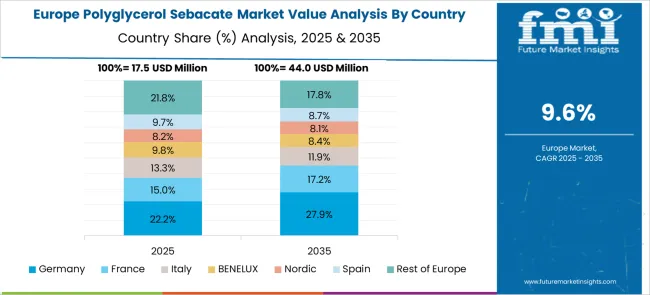
Germany is expected to grow at a CAGR of 12.2%, aided by its mature medical devices sector and emphasis on EU-compliant biodegradable polymers. German firms are testing PGS for neuroengineering, cardiac patches, and 3D-printed implants. Academic-medical partnerships are influencing strict quality standards for PGS elastomers. Demand from dental and orthopedic specialists has grown for PGS-based membranes and scaffolds with tailored degradation rates. Recyclable packaging and skin-safe cosmetic applications are emerging as parallel avenues for growth.
The United Kingdom is projected to record a CAGR of 10.1% due to its integration of polyglycerol sebacate in responsive drug delivery systems and wearable biocompatible electronics. Research hubs in Cambridge and London are developing PGS blends with shape-memory properties. Regulatory easing post-Brexit has enabled faster prototyping for personalized medical devices utilizing PGS. UK-based material science firms are also leveraging PGS in cosmetic creams and post-surgery skin applications due to its elasticity and non-toxicity.
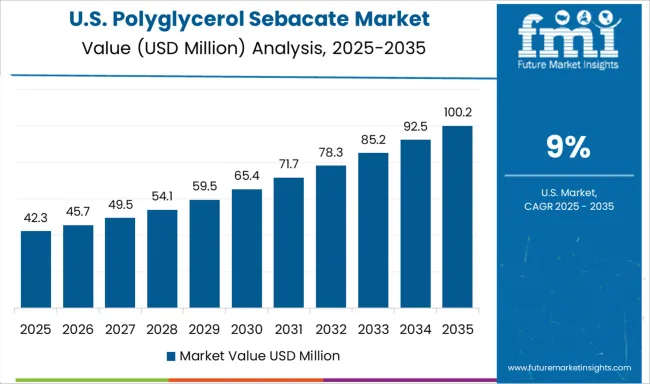
The United States is anticipated to grow at a CAGR of 9.0% owing to its leadership in advanced biomaterials and commercialization of patient-specific devices. Leading medical universities and biotech firms are advancing PGS-based hydrogel platforms for cartilage repair and nerve conduits. FDA pilot pathways are supporting device makers in obtaining early market access. Interest has also expanded into aesthetic medicine, with PGS explored for dermal fillers and reconstructive supports. Integration into 3D bioprinting systems is providing scalable production routes.
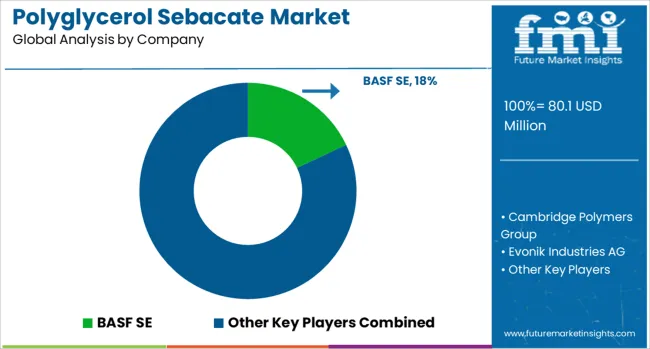
The polyglycerol sebacate (PGS) market represents a niche but critical segment within the biomedical materials landscape, driven primarily by its application in soft tissue engineering, nerve regeneration, and drug delivery systems. PGS’s key advantages, including its elastomeric nature, biocompatibility, and biodegradability, make it highly suited for implantable medical devices.
The competitive ecosystem involves a blend of chemical corporations, medical polymer developers, and research-oriented suppliers. BASF SE and Evonik Industries AG lead from a raw material synthesis standpoint, offering high-purity sebacic acid and glycerol derivatives that are fundamental to scalable PGS production. Sigma-Aldrich (Merck Group) addresses academic and prototyping needs by providing catalog-based PGS variants with lab-grade specifications.
Cambridge Polymers Group and PolySciTech (Akina, Inc.) are prominent in developing custom PGS formulations tailored for specific biomedical research projects and device designs. Orthofix International NV and Secant LLC are focused on applying PGS in clinical-grade applications, particularly in resorbable scaffolds used for tendon and ligament repair.
Resinex and Fuso Chemical Co., Ltd. add value through intermediate chemical manufacturing and monomer specialization, which supports customized PGS production. Meanwhile, Polymers LLC and Synthecon Inc. offer capabilities in functional polymer synthesis and bioreactor-based fabrication techniques, catering to research institutions and early-stage developers.
Market dynamics are influenced by the shift toward biodegradable materials, regulatory demands for biocompatibility, and the rise of personalized medical implants. Companies with proven medical polymer expertise, robust customization support, and regulatory alignment are expected to gain long-term traction in this innovation-led domain.
| Item | Value |
|---|---|
| Quantitative Units | USD 80.1 Million |
| Form | Soft gel, Paste, Extruded products, and Others |
| Application | Drug delivery, Tissue engineering, Adhesives, Coatings, and Others |
| Regions Covered | North America, Europe, Asia-Pacific, Latin America, Middle East & Africa |
| Country Covered | United States, Canada, Germany, France, United Kingdom, China, Japan, India, Brazil, South Africa |
| Key Companies Profiled | BASF SE, Cambridge Polymers Group, Evonik Industries AG, Fuso Chemical Co., Ltd., Orthofix International NV, Polymers LLC, PolySciTech (Akina, Inc.), Resinex, Secant LLC, Sigma-Aldrich (Merck Group), and Synthecon Inc. |
| Additional Attributes | Dollar sales by grade type and application segment, demand dynamics across biomedical devices, tissue engineering, and cosmetic formulations, regional trends in research and commercial usage across North America, Europe, and Asia-Pacific, innovation in biodegradable elastomers, surface functionalization techniques, and bio-based synthesis pathways, environmental impact of raw material sourcing, biocompatibility, and degradation byproducts, and emerging use cases in drug delivery systems, flexible electronics substrates, and natural polymer replacements in skin-contact products. |
The global polyglycerol sebacate market is estimated to be valued at USD 80.1 million in 2025.
The market size for the polyglycerol sebacate market is projected to reach USD 219.4 million by 2035.
The polyglycerol sebacate market is expected to grow at a 10.6% CAGR between 2025 and 2035.
The key product types in polyglycerol sebacate market are soft gel, paste, extruded products and others.
In terms of application, drug delivery segment to command 42.0% share in the polyglycerol sebacate market in 2025.






Our Research Products

The "Full Research Suite" delivers actionable market intel, deep dives on markets or technologies, so clients act faster, cut risk, and unlock growth.

The Leaderboard benchmarks and ranks top vendors, classifying them as Established Leaders, Leading Challengers, or Disruptors & Challengers.

Locates where complements amplify value and substitutes erode it, forecasting net impact by horizon

We deliver granular, decision-grade intel: market sizing, 5-year forecasts, pricing, adoption, usage, revenue, and operational KPIs—plus competitor tracking, regulation, and value chains—across 60 countries broadly.

Spot the shifts before they hit your P&L. We track inflection points, adoption curves, pricing moves, and ecosystem plays to show where demand is heading, why it is changing, and what to do next across high-growth markets and disruptive tech

Real-time reads of user behavior. We track shifting priorities, perceptions of today’s and next-gen services, and provider experience, then pace how fast tech moves from trial to adoption, blending buyer, consumer, and channel inputs with social signals (#WhySwitch, #UX).

Partner with our analyst team to build a custom report designed around your business priorities. From analysing market trends to assessing competitors or crafting bespoke datasets, we tailor insights to your needs.
Supplier Intelligence
Discovery & Profiling
Capacity & Footprint
Performance & Risk
Compliance & Governance
Commercial Readiness
Who Supplies Whom
Scorecards & Shortlists
Playbooks & Docs
Category Intelligence
Definition & Scope
Demand & Use Cases
Cost Drivers
Market Structure
Supply Chain Map
Trade & Policy
Operating Norms
Deliverables
Buyer Intelligence
Account Basics
Spend & Scope
Procurement Model
Vendor Requirements
Terms & Policies
Entry Strategy
Pain Points & Triggers
Outputs
Pricing Analysis
Benchmarks
Trends
Should-Cost
Indexation
Landed Cost
Commercial Terms
Deliverables
Brand Analysis
Positioning & Value Prop
Share & Presence
Customer Evidence
Go-to-Market
Digital & Reputation
Compliance & Trust
KPIs & Gaps
Outputs
Full Research Suite comprises of:
Market outlook & trends analysis
Interviews & case studies
Strategic recommendations
Vendor profiles & capabilities analysis
5-year forecasts
8 regions and 60+ country-level data splits
Market segment data splits
12 months of continuous data updates
DELIVERED AS:
PDF EXCEL ONLINE
Polyglycerol Polyricinoleate Market Analysis - Demand, Trends & Forecast 2025 to 2035
Polyglycerol Esters Of Fatty Acids Market
Demand for Polyglycerol Polyricinoleate (PGPR) in the EU Size and Share Forecast Outlook 2025 to 2035

Thank you!
You will receive an email from our Business Development Manager. Please be sure to check your SPAM/JUNK folder too.
Chat With
MaRIA